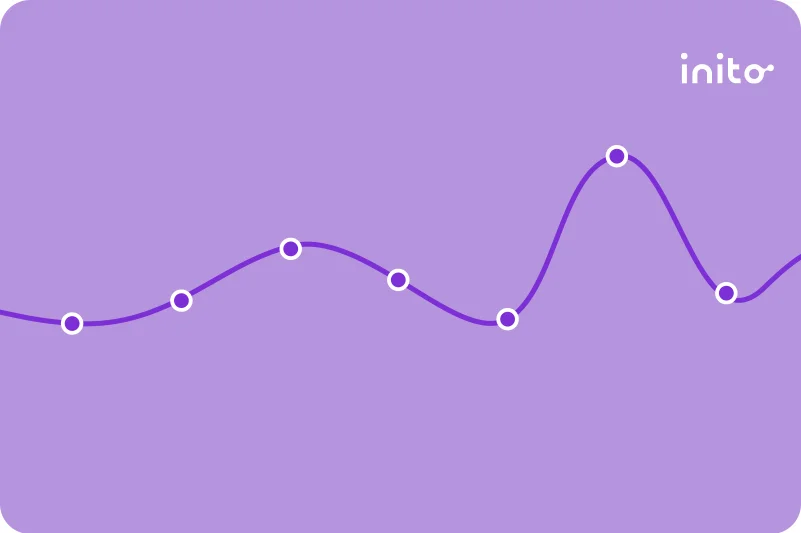Content table
Can topical progesterone creams moisturize your skin and boost your ability to become pregnant?
In a perfect world, yes!
But unfortunately, we do not live in a perfect world. There’s little proof that progesterone creams help manage progesterone levels while pregnant or TTC.
Progesterone creams do have their time and place though. Many menopausal women use these OTC creams to help with menopause symptoms.
Just to make things more confusing, there’s a slew of vaginal creams and gels on the market that are effective in boosting fertility.
How do you know what works and what doesn’t? What’s a gal to do?
First, read this article! We’re going to clear up the confusion and explain everything you need to know about progesterone creams. Let’s begin by reviewing why progesterone is so important for pregnancy.
A brief review of progesterone’s role in pregnancy
Progesterone likes to keep you on your toes by fluctuating throughout your menstrual cycle.
At the beginning of your cycle, your progesterone levels are low. They stay low through your follicular phase. But once you ovulate, the follicle that released the egg (a.k.a. the corpus luteum) starts to produce higher levels of progesterone.
After ovulation, you move into your luteal phase. Here, progesterone levels tend to remain elevated. Progesterone is hard at work building up your uterine lining so an embryo can implant and grow.
But progesterone doesn’t stop there!
Progesterone also keeps your uterus from contracting. This is one of the hormone’s most vital functions. Because news flash: uterine contractions can interrupt the implantation process.
If the egg implants successfully, you are officially pregnant. Yay! In this case, the corpus luteum continues releasing progesterone at higher levels. Eventually, the placenta will take on this vital role of producing progesterone.
Some other ways progesterone helps you after successful implantation:
- Keeps you from ovulating so you don’t get pregnant again
- Limits uterine contractions later on in pregnancy which helps prevent preterm labor
- Ensures your immune system doesn’t reject the fetus
- Triggers the breast tissue to develop and prepare for milk production and breastfeeding
In short, progesterone is the star player of the sex hormone squad. It helps you get pregnant and stay pregnant.
Now let’s take a look at how progesterone creams work.
What is a topical progesterone cream, and how does it work?
Topical progesterone creams are like other creams you use on your skin. They may not smell as nice as your lavender-scented lotion, but you apply them the same way. Once applied they get absorbed into the skin and enter your bloodstream.
Now, let’s clear up confusion about the different types of progesterone creams and gels. Typically, a topical progesterone cream is used by menopausal women. However, some women of reproductive age use them to aid with fertility. These types of creams are accessible since they don’t require a prescription.
But there’s one important thing to know about topical progesterone creams! They are actually considered to be a cosmetic and not a medication. This means that they are not regulated by the FDA.
Other progesterone therapy products like vaginal creams and vaginal gels are more commonly used for treating low progesterone levels in women of reproductive age. For these types, you do need a prescription.
Here’s how to use a vaginal progesterone gel:
- You have an applicator that is pre-filled with a gel containing progestins.
- While sitting or laying on your back with your knees bent, you insert the applicator into your vagina.
- Then you use your fingers to squeeze the thicker end of the applicator.
- When you do this, it will push the gel into your vagina so the progesterone can absorb into your bloodstream.
Still unsure if progesterone creams are a good fit for you? Let’s explore who can benefit the most from progesterone creams.
Who should use progesterone creams?
As mentioned, topical progesterone creams tend to be used by menopausal women. They’re not generally recommended for improving fertility.
If you want to increase your progesterone levels for fertility reasons, a vaginal progesterone gel is a better option. There are other progesterone alternatives like IM or suppositories.
Keep this in mind though. Progesterone supplements will not be useful if you have normal progesterone levels. Only a select part of the population will benefit from using them.
Here are some cases in which vaginal progesterone gels can help with low progesterone:
Women with luteal phase defects
A luteal phase defect occurs when your body does not properly prepare for pregnancy after ovulation. This can happen if:
The corpus luteum fails to release enough progesterone after ovulation.
The body does not respond to high levels of progesterone.
Read More: Your Guide to Luteal Phase Defects
History of recurrent miscarriages or unexplained infertility
A recurrent miscarriage is defined as two or more pregnancy losses. Unexplained infertility occurs when couples fail to conceive after one year of trying in spite of all tests being normal. Low levels of progesterone can increase the odds of recurrent miscarriages. Some studies have found that progesterone supplements can help prevent this.
Women undergoing fertility treatments
If you undergo IVF or IUI, your doctor may prescribe a progesterone supplement. This could be in the form of a vaginal gel, suppository, or injections. These provide hormonal support during fertility treatment and may help increase the success rate.
History of preterm birth or shortened cervix
Vaginal progesterone can be helpful if you have a history of preterm birth or a short cervix. One study involving 458 women with a shortened cervix sheds light on this. For the patients who used vaginal progesterone, the preterm birth rate was reduced by 45%.
Note: Talk to your doctor before deciding to use any sort of hormone replacement therapy or progesterone.
If you and your doctor decide progesterone creams are a good fit for you, it’s important to use them correctly. Let’s explore how to use progesterone creams safely.
How to use progesterone creams safely
Topical progesterone creams are easy to find OTC (even on places like Amazon), but their composition and dosing amounts vary.
The first step to using progesterone creams safely is to talk to your doctor. They will be able to determine if it is a safe option for you. From there, you can follow their directions on how to use them correctly.
Similarly, if you’re using a vaginal progesterone gel, make sure you follow the directions on the label and from your doctor carefully.
Your physician may also recommend an alternative like a vaginal progesterone suppository. These are safe to use and effective for women of reproductive age with low progesterone levels.
Side effects of progesterone creams
Any medication or topical cream you use could have side effects, so make sure you understand why you are taking them. Consider if the benefits outweigh the risks. And always talk to your doctor before using a progesterone cream or supplement.
Side effects are dependent on your dosage and the potency of the specific cream you are using.
Topical progesterone cream side effects may include the following:
- Inflammatory lesions
- Facial hair
- Facial pigmentation
Keep in mind that most of the side effects are due to reactions at the application site.
If you are using a vaginal progesterone gel, you may experience some minor side effects due to increased levels of progesterone. These include the following:
- Breast tenderness or pain
- Headaches
- Vaginal spotting
- Stomach cramping or bloating
- Vaginal yeast infection
- Nausea and vomiting
- Dizziness
More concerning side effects are possible but rare. All in all, play it safe and ask your doctor first!
Since progesterone creams are best for menopausal women, what options do you have if you’re TTC or pregnant? Let’s look at a few alternatives.
Looking for a progesterone cream alternative for pregnancy?
There are many other supplements out there besides gels and creams that can help increase progesterone levels. These include intramuscular injections and vaginal suppositories.
IM and vaginal progesterone have been proven to help with TTC but require a prescription. Consult your doctor about the right treatment plan for you.
Here are some things to keep in mind about each of these progesterone cream alternatives:
Progesterone suppositories
These are cone-shaped suppositories that you insert into your vagina (like a tampon). They are absorbed into your bloodstream via the vaginal wall in as little as 30 minutes. Because of where they are inserted, they have a powerful localizing effect.
You need to lay on your back for about 15 minutes after insertion to decrease leakage. You may experience temporary, light discharge that is caused by the melting of the suppository.
Read More: Progesterone Suppositories: The Ultimate How-To Guide!
Intramuscular injections (IM)
With IM, progesterone is dissolved into an oil medium and then injected into your muscle. The injection site is usually your buttocks or glutes.
Based on a study of 400+ women, IM and vaginal progesterone had a similar rate of effectiveness. But if you hate needles, this may not be the best option for you.
Read More: Progesterone Injections: Who, What, When, Where, Why, and How
Using a progesterone cream while tracking with Inito
If you use a progesterone cream or any other form of progesterone, you may be wondering…
Will using progesterone affect my results on the Inito Fertility Monitor?
Here’s what you need to know:
- The Inito Fertility Monitor gives you the exact value of PdG (metabolite of progesterone) levels in your urine. This reading helps you confirm ovulation.
- Using progesterone supplementation alters the levels of progesterone in your system. This increases the amount of PdG in your urine.
- If you use a progesterone treatment before you ovulate, it’s possible to get a false positive. This means an “ovulation confirmed” result could be inaccurate.
The best approach is to first make sure ovulation is confirmed on your fertility monitor. This is indicated by the rise in your progesterone metabolite PdG levels. Then you can begin your progesterone supplementation.
Still confused by the results on your monitor while using progesterone? Speak with your fertility specialist or health care provider.
More answers to your progesterone cream questions
When should you use progesterone cream?
Topical progesterone creams are best for women treating menopausal and perimenopausal symptoms. But vaginal gels and creams do have use when it comes to pregnancy and fertility. Consult your doctor if using these creams while trying to conceive or if you are pregnant.
What happens when you use progesterone cream?
Using a natural progesterone cream will increase the amount of progesterone in your body. Once the cream gets absorbed through your skin, progesterone travels into your bloodstream. You may experience some side effects after using the cream due to higher levels of progesterone.
Are progesterone creams safe?
If you are pregnant or TTC, it’s important to know that topical progesterone creams are not regulated by the FDA. Therefore, it is not a good idea to use them before consulting your doctor. Using any form of progesterone treatment without supervision is not recommended.
What are the signs of low progesterone?
Some signs of low progesterone include:
- Decreased sex drive
- Infertility
- Miscarriage or recurrent miscarriage
- Irregular menstrual cycles
- Mood swings
- Headaches
- Hot flashes
How can I increase my progesterone naturally?
Lowering your stress levels is a great way to increase natural progesterone levels. Consuming more foods rich in zinc and Vitamins B and C can also help.
Takeaways
- Progesterone is vital for successful implantation and a healthy pregnancy.
- Topical progesterone creams can help increase the amount of progesterone in your body. All you do is apply the cream to your skin.
- Menopausal and postmenopausal women may benefit from topical progesterone creams. This could include relief from hot flashes and other menopausal symptoms.
- If you are trying to conceive or are already pregnant, topical progesterone cream is not recommended. Check with your doctor before using any sort of progesterone cream or hormone replacement therapy.
- Progesterone injections or vaginal progesterone are better for women who need a progesterone boost for fertility reasons.
- A natural progesterone cream can cause side effects or even allergic reactions. Always consult your doctor before using a progesterone cream.
Was this article helpful?
- Physiology, Progesterone – StatPearls – NCBI Bookshelf
- Updated Clinical Guidance for the Use of Progesterone Supplementation for the Prevention of Recurrent Preterm Birth | ACOG
- Menopause: Medicines to Help You | FDA
- Progesterone Vaginal: MedlinePlus Drug Information
- Effects and side‐effects of 2% progesterone cream on the skin of peri‐ and postmenopausal women: results from a double‐blind, vehicle‐controlled, randomized study
- Sexual Absorption of Vaginal Progesterone: A Randomized Control Trial – PMC
- Intramuscular progesterone (Gestone) versus vaginal progesterone suppository (Cyclogest) for luteal phase support in cycles of in vitro fertilization–embryo transfer: patient preference and drug efficacy – PMC
- Over‐the‐Counter Progesterone Cream Produces Significant Drug Exposure Compared to a Food and Drug Administration‐Approved Oral Progesterone Product – Hermann
- Progesterone to prevent miscarriage in women with early pregnancy bleeding: the PRISM RCT
- Efficacy and tolerability of vaginal progesterone capsules (Utrogest™ 200) compared with progesterone gel (Crinone™ 8%) for luteal phase support during assisted reproduction – Fertility and Sterility
- Vaginal progesterone pessaries for pregnant women with a previous preterm birth to prevent neonatal respiratory distress syndrome (the PROGRESS Study): A multicentre, randomised, placebo-controlled trial | PLOS Medicine











